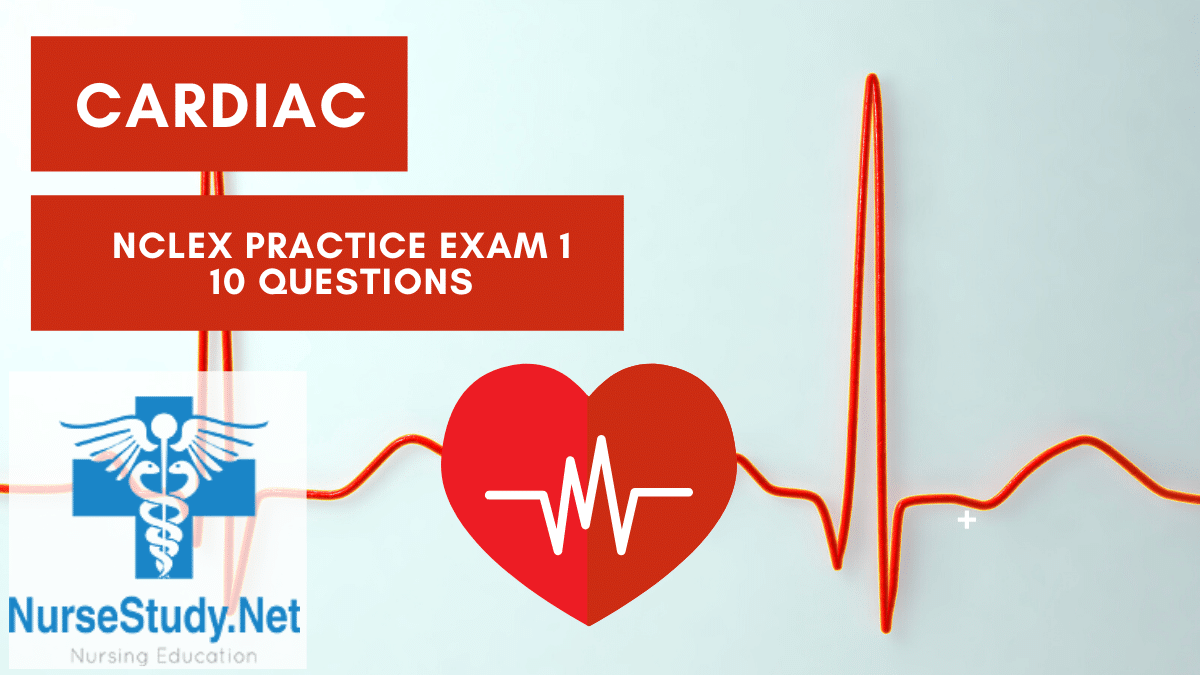Last updated on October 8th, 2021 at 10:02 am
Start Cardiac Quiz 10 Questions.
Cardiac NCLEX review practice questions with rationales.
Results
Last updated on October 8th, 2021 at 10:02 am
Great JobLast updated on October 8th, 2021 at 10:02 am
Almost There Try Again
#1. A 52-year old male patient arrives in the cardiac unit and is diagnosed with congestive heart failure. The cardiologist prescribes hydrochlorothiazide for him. Which of the following statements show that the patient understands your teaching about this medication?
Answer: A: Dizziness is a common side effect of this drug, so I need to get up the bed or chair slowly.
Rationale: Hydrochlorothiazide is a diuretic drug that is indicated for hypertension, heart failure, and kidney diseases. Dizziness is the most common side effect of hydrochlorothiazide. Quick changes of position may trigger dizziness, lightheadedness or even fainting. Other common side effects include headache and stomach upset.
#2. . A public health nurse is conducting a community health teaching about heart failure . All of the following should be mentioned as risk factors for heart failure, except:
Answer: C
Rationale:
High density lipoproteins (HDL) are known as “good cholesterol” because they carry cholesterol to the liver for excretion. Increased low density lipoproteins (LDL) or “bad cholesterol” could cause a greater buildup of cholesterol in the arterial walls. This can eventually cause heart disease. Diastolic dysfunction is primarily seen in people with sleep apnea. Hypertension and obesity increase cardiac workload and peripheral vascular resistance. Hypertension is commonly seen in women with history of pre-eclampsia.
#3. A 72-year old patient came to the cardiac unit and is diagnosed with anterior wall myocardial infarction (AWMI). The nurse looking after this patient understands that the anterior cardiac wall is supplied with blood by which of the following arteries?
Answer: B
Rationale: The left anterior descending artery is responsible for the blood supply of the anterior wall of the heart. AWMI occurs when there is a lesion near the left anterior descending artery.
#4. A 55-year old male patient is showing signs of coronary artery disease (CAD) and is very anxious. What is the first nursing intervention that the healthcare provider should perform for this patient?
Answer: D
Rationale: Hypoxemia is a medical emergency that is common with patient diagnosed with coronary artery disease. Therefore, the first nursing action is to improve the oxygen supply to the myocardium. If there is acute angina, then sublingual nitroglycerin is recommended.
#5. A community health nurse teaches a group of older adults regarding common heart problems. The nurse should tell the group that the most common sign of myocardial infarction is:
Answer: C
Rationale: The most common sign of myocardial infarction is chest pain, characterized as burning, squeezing, and/or heaving feeling. The pain can radiate to the left arm, neck, or shoulder. Shortness of breath usually follows chest pain.
#6. A nurse is doing a focused physical assessment on a patient suspected to have heart disease. To assess the apical pulse of the patient, which landmark should the nurse use?
Answer: C
Rationale: The nurse should look for the left fifth intercostal space, midclavicular line to assess the apical pulse of the patient. This is where the left ventricular apex and the point of maximum impulse are found. Pulmonary sounds can be auscultated from the left second intercostal space midclavicular line.
#7. Upon doing auscultation to a 43-year old female patient, the healthcare provider hears a murmur along the left sternal border, at the left second intercostal space. The healthcare provider suspects that the blood vessel involved is:
Answer: A
Rationale: The pulmonic valve can be auscultated from the second left intercostal space at the left sternal border. Murmurs are abnormal sounds of the pulmonic valve, which may suggest pulmonic hypertension.
#8. A 64-year old female patient comes into the emergency room with a chief complaint of severe chest pain. To assess myocardial damage, the nurse should expect the doctor to order which of the blood tests?
Answer: B
Rationale: Within one hour of myocardial damage, rapid elevation of the Troponin I levels can be detected. A person with no heart injury has no detectable Troponin I level. LDH is also helpful in the diagnosis of cardiac damage; however, LDH is also found in other body tissues and not specific to cardiac muscles.
#9. A 39-year old male patient diagnosed with myocardial infarction is prescribed morphine. Which of the following is the rationale for administering this medication?
Answer: A
Rationale: The patient with myocardial infarction requires lowering of the oxygen demand to the myocardial tissues. Morphine helps to achieve this particular goal, although it can help reduce pain and anxiety levels.
#10. A patient with congestive heart failure develops pulmonary edema. The doctor prescribes furosemide (Lasix) for the patient. In conjunction with furosemide, which of the following medications should the nurse ask the doctor to prescribe?
Answer: B
Rationale: Furosemide is a loop diuretic used in the treatment of cardiogenic pulmonary edema. Furosemide expels water along with salt and potassium from the body. A patient on furosemide should be monitored for decreased serum potassium levels. The nurse should query to the physician whether the patient requires a potassium drip to make up for the loss of this electrolyte.
#11. A 45-year old male patient is newly diagnosed with stage I hypertension. Which of the following medications can be used to reduce his blood pressure, considering he has a relatively normal kidney function?
Answer: D
Rationale: Bendroflumethiazide is a thiazide diuretic that can be used to treat hypertension in patients with relatively normal kidney function. It reduces fluid retention, as well as the risk for heart failure and stroke. Furosemide, Bumetanide, and Spironolactone are also diuretics, but are the choice of treatment if the patient is resistant to thiazide or has renal impairment.


